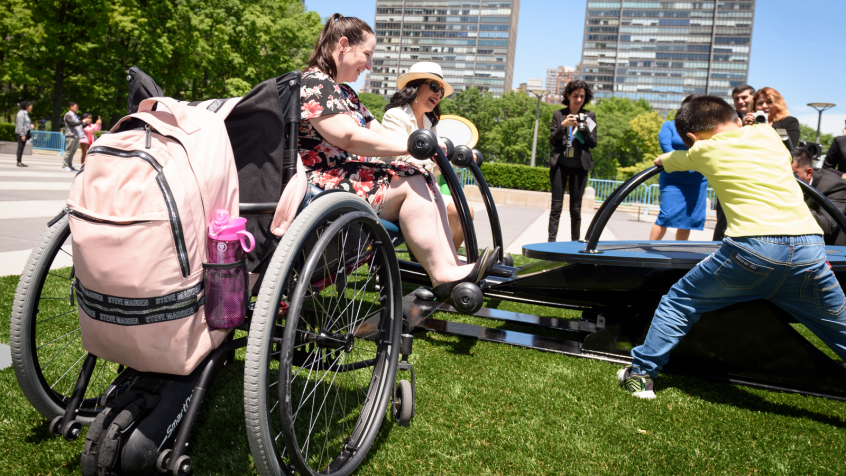
Climate Change and Health Impacts on Disabled Individuals
Introduction:
Climate change is a global crisis that affects various aspects of our lives, including our health. The impacts of climate change on health are diverse and can be particularly significant for vulnerable populations, including disabled individuals. Climate change can worsen air pollution, increase the occurrence of allergens, and lead to extreme weather events, which can have detrimental effects on the health of disabled individuals. This article aims to explore the specific health impacts of climate change on disabled individuals and identify key measures to address these challenges.

- Air Pollution:
Climate change contributes to the worsening of air quality through various mechanisms such as increased wildfires, higher emissions from industrial activities, and changes in temperature and precipitation patterns. Poor air quality can exacerbate respiratory conditions, which are already common among disabled individuals. Those with conditions such as asthma, chronic obstructive pulmonary disease (COPD), and other respiratory disorders may experience more frequent and severe symptoms due to heightened exposure to air pollutants. It is crucial to implement strategies to reduce air pollution and improve indoor air quality, especially for disabled individuals who may spend more time indoors. - Extreme Weather Events:
Climate change leads to more frequent and intense extreme weather events, such as heatwaves, hurricanes, and flooding. These events can endanger the health of disabled individuals in multiple ways. Heatwaves, for example, can cause heat-related illnesses, particularly for those with limited mobility or impaired ability to regulate body temperature. Individuals with disabilities may also face challenges in evacuating or accessing appropriate shelter during hurricanes and floods. Disaster preparedness plans must consider the specific needs of disabled individuals and address accessibility-related issues to ensure their safety during extreme weather events. - Allergens:
Climate change can also influence the occurrence and distribution of allergens such as pollen, mold, and dust mites. Increased temperatures and changes in precipitation patterns can extend the pollen season, intensify pollen concentrations, and promote the growth of mold. This can result in increased allergies and asthma attacks among disabled individuals who are already susceptible to respiratory conditions. Effective management of environmental allergens through comprehensive prevention, early warning systems, and accessible healthcare services is crucial to minimize the adverse health effects on disabled individuals. - Vector-Borne Diseases:
Climate change impacts the distribution and prevalence of vector-borne diseases such as Lyme disease, West Nile virus, and dengue fever. Disabled individuals may face increased vulnerability to these diseases due to challenges in protecting themselves from vector bites, limited mobility, or impaired immune systems. It is essential to implement effective mosquito and tick control measures, raise awareness, and provide accessible healthcare services to prevent and manage these diseases among disabled individuals. - Mental Health:
Climate change-related events such as natural disasters and displacement can have profound psychological impacts on individuals, including disabled individuals. These events can result in loss of lives, homes, and social support systems, leading to increased stress, anxiety, depression, and post-traumatic stress disorder (PTSD). Disabled individuals may face additional challenges in coping with these mental health issues due to limited access to support services, increased dependence on caregivers, or disruptions to daily routines. Adequate mental health support must be provided to address these challenges and promote resilience among disabled individuals in the face of climate change-related stressors. - Access to Healthcare:
Climate change can strain healthcare systems, making it more challenging for disabled individuals to access necessary medical care. Transportation disruptions during extreme weather events, overwhelmed healthcare facilities, and interruptions in medication supplies can pose significant barriers for disabled individuals seeking healthcare services. It is crucial to ensure that healthcare systems have robust plans in place to maintain access to healthcare services for disabled individuals during climate-related emergencies and address any barriers in accessing necessary medication and medical equipment. - Heat-Related Mortality:
Rising temperatures due to climate change are associated with an increased risk of heat-related mortality and morbidity, particularly among vulnerable populations. Disabled individuals, especially those with limited mobility or underlying health conditions, are at higher risk. The provision of cooling centers, access to air-conditioning, and targeted public health campaigns can play a pivotal role in reducing heat-related morbidity and mortality among disabled individuals during heatwaves.

Conclusion:
The health impacts of climate change on disabled individuals are diverse and can significantly affect their overall well-being. It is imperative to recognize and address these unique challenges to ensure their health and safety in the face of climate change. Implementing strategies to reduce air pollution, improving disaster preparedness for extreme weather events, managing allergens, preventing vector-borne diseases, promoting mental health support, and ensuring accessible healthcare services are crucial steps in protecting the health of disabled individuals. By adopting an inclusive and comprehensive approach, we can work towards a healthier and more resilient future for all.
All Categories
- Agricultural Methods
- Agriculture and Women Small Farmers Rights Awareness
- Climate Change
- Disable and Human Rights
- Disable Jobs
- Donation
- Education
- Health Issues
- Organic Foods
- Organic Vegetables
- Orphans Children
- Plastic production and disposal
- Services
- Sinking in Scarcity
- Success Stories
- Uncategorized
- Waste Management
- Women Rights
- Youth Empowerment




